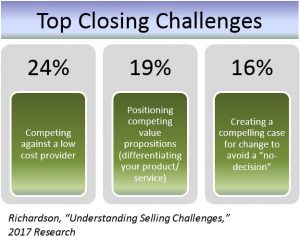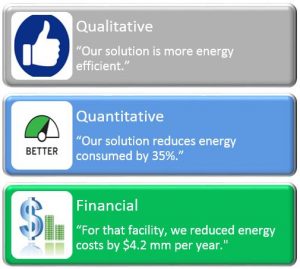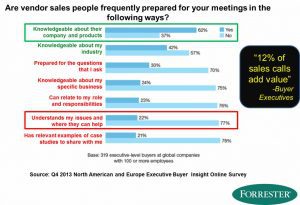B2B buyers usually have hectic schedules. Yet they make time for some sales conversations. Why?
Busy executives take a sales call because getting live answers to a few key questions is faster than searching the internet for answers. Invariably buyers want to understand what you do for your customers. They are usually looking for crisp answers to:
- Can you deliver meaningful, reliable business results to customers like us?
- What are the 2 or 3 impactful differences between your solution and the alternatives?
In a buyer survey, Forrester Research found that, “the first vendor to succeed in communicating a vision to executives wins the business 74% of the time.” The key to that win rate, according to Forrester, is that the winning vendor works with the buyer to turn the vision into “a clear path to value.” Winning sales teams find a way to build buyer confidence in their Value Proposition.
Value Propositions: Themes and Variations. But what is a Value Proposition? Consultants, strategists, advisors and sales trainers talk about “Value Propositions” but their meanings vary. Value Propositions range from appealing photos of customers benefitting through better technology to bullet-point product positioning summaries to detailed spreadsheets of how much money the customer can make by buying your solution. The best commercial teams connect the images to the words to the persuasive and memorable math in providing the customer with a consistent vision of value.
Good Value Propositions provide a way to engage in an evolving conversation with customer stakeholders about what you can do for them. Sales teams need a Value Proposition that is effective at all stages of the sales cycle with or without the involvement of experts on the sales team with specialized knowledge and skills. As sales conversations progress, a Value Proposition needs to be adaptable to customer specifics, customer needs and customer stakeholder interests. As a consequence, a sales-ready Value Proposition must have layers that can be used consistently by sales teams with cumulative effect through a series of customer discussions.
Value Proposition Objectives. In a 2017 executive survey, Richardson found that the three most significant sales challenges are to: (1) compete with low cost alternatives, (2)  differentiate your product or service through your Value Proposition, and (3) create a compelling case for change to overcome a customer “no decision.”
differentiate your product or service through your Value Proposition, and (3) create a compelling case for change to overcome a customer “no decision.”
Good Value Propositions address all three issues. Value Propositions are a customer-centric way to highlight what you do better than the low cost provider. Value Propositions qualitatively and quantitatively differentiate your product or service. Value Propositions provide a clear business case as to why your customer would be better off buying your solution versus opting for a “no-decision.”
3 Layers of a Value Proposition. Good Value Propositions provide quantified financial answers to the question of “why buy?” Winning Value Propositions recognize that not all elements of the financial case are necessarily useful in all customer conversations. B2B sales processes require a series of steps that include qualifying an account, identifying stakeholders, understanding and collaboratively formulating a customer’s buying process, obtaining a customer commitment to evaluate and persuading the customer that your solution is both worth the money and better than the alternatives. At most stages of the process, this means that the objective is not to get into the end zone on every play, but is instead to move the ball down the field.
 Some financial Value Propositions with terrific content are designed as a closing document. Strong Value Propositions should be designed to play a more versatile role in advancing the ball without going for broke. To do this, Value Propositions work best if their content is layered. As illustrated to the right, what you do for your customers can be expressed in three ways:
Some financial Value Propositions with terrific content are designed as a closing document. Strong Value Propositions should be designed to play a more versatile role in advancing the ball without going for broke. To do this, Value Propositions work best if their content is layered. As illustrated to the right, what you do for your customers can be expressed in three ways:
- Qualitative
- Quantitative
- Financial
Using a Layered Value Proposition. In seeing how a layered Value Proposition can be used, let’s work backwards from the end result through a typical B2B buying process.
 Decide and Purchase. A strong Financial Value Proposition is an endpoint that provides a Business Case to Buy that can be shared and agreed with a customer sponsor as their organization decides and goes through its purchase mechanics. As an endpoint of an evaluation process, a Business Case to Buy shared with a sponsor helps speed the closing process and obtain better pricing outcomes as legal, procurement and finance get involved on the buyer side.
Decide and Purchase. A strong Financial Value Proposition is an endpoint that provides a Business Case to Buy that can be shared and agreed with a customer sponsor as their organization decides and goes through its purchase mechanics. As an endpoint of an evaluation process, a Business Case to Buy shared with a sponsor helps speed the closing process and obtain better pricing outcomes as legal, procurement and finance get involved on the buyer side.
A sales team that is prepared to work with a sponsor in building that shared Business Case to Buy has an edge. Whether or not the team gets into details of the financial case before or during a closing process, knowing that they can do so quickly and crisply builds sales confidence at points in the buying cycle where a price negotiation is most likely. CRM data from organizations adopting value selling show that closed opportunities where a Value Proposition is used achieve 5-25% higher price outcomes.For great sales teams who have engaged a buyer without a competitor emerging on the scene, a Quantitative Value Proposition is often enough. Sometimes the magnitude of a solution’s quantitative impact is obvious enough without a lot of buyer math. This is where the optionality of stopping at a quantitative Value Proposition is useful. A layered Value Proposition helps. Why slow down a buying process by getting into the weeds of a detailed financial analysis when it isn’t necessary?
The problem is that sales teams can never tell when a quantitative Value Proposition will be good enough and when it will make sense to refine a quantitative Value Proposition into a financial Value Proposition. A layered Value Proposition provides sales teams with flexibility to understand customer specifics earlier in the sales process and take what they know to build a shared Business Case to Buy with a customer sponsor when and if it makes sense.- Evaluate. A Value Proposition can provide a basis for stakeholder conversations as buyers evaluate solutions in their buying process. Buyers with RFP processes invariably spend time evaluating what is possible and what they want well before they put out their RFPs. This is a critical time for sales conversations to help mold the RFP to your advantages and your points of differentiation. For less formal buying processes, especially where innovative solutions are under consideration, evaluation usually involves a number of stakeholders with different interests looking at different aspects of your solution to build a consensus to move forward.
During the evaluation phase for complex enterprise offerings, B2B solution sales often involve presales team members including subject matter experts, solution consultants, product managers, sales engineers and other presales professionals. In the evaluation phase, most sales teams have a number of objectives. Important among them are:- Credentialize. Sales teams, especially presales professionals, need to demonstrate that they know how to apply your solution to the customer’s situation. A Value Proposition does this but it is not always necessary to go all the way to financial results. Having the ability to engage with a qualitative or quantitative Value Proposition may be sufficient for a presales professional to show that they understand the customer’s business.
- Engage. Technical experts are not always the best conversationalists. Sales
 professionals know that they need to get customers talking. For both sales and presales, using a Qualitative Value Proposition as part of a presentation stimulates questions like, “has this been an issue for you?” Using a Quantitative Value Proposition can be a prompt for questions like, “do you know what you spend on energy at this facility?” or, “would a 35% reduction in energy costs move the needle for you?” A long list of customer discovery questions can be a customer turnoff while a value story or a Case Study can invite customer collaboration that engages and builds trust.
professionals know that they need to get customers talking. For both sales and presales, using a Qualitative Value Proposition as part of a presentation stimulates questions like, “has this been an issue for you?” Using a Quantitative Value Proposition can be a prompt for questions like, “do you know what you spend on energy at this facility?” or, “would a 35% reduction in energy costs move the needle for you?” A long list of customer discovery questions can be a customer turnoff while a value story or a Case Study can invite customer collaboration that engages and builds trust. - Customize. A consequence of more natural discovery, better engagement and customer collaboration is that sales teams learn more about the customer. This is key in customizing a solution in a way that improves your positioning. It is also key in customizing proposals and presentations to address problems and concerns that will resonate with customer sponsors and stakeholders. Qualitative, quantitative and financial Value Propositions all contribute to this objective. Keep it simple by having the option to go only as deep as necessary.
- Prove. Proof is not the only objective during the evaluation phase, but it often matters. Proof sufficient to drive a sale rarely rises to the level of rigor that mathematicians, logicians and FDA teams would set. Setting too high a standard of proof for a Value Proposition can slow or stop a sale. A financial Value Proposition is designed to take proof conversations the furthest, but often that is unnecessary. Having the option to keep the conversation qualitative or quantitative may be enough for a specific stakeholder. A layered Value Proposition helps sales teams go as far as they need to go in a conversation without playing all their cards.
- Identify and Prioritize. At the beginning of a buying process, sales teams need a way to get into effective customer conversations. Good reps grapple with how to rise above the CEB statistic that prospects are 57% of the way through their buying process before they contact a sales rep. Value Propositions become a way for them to qualify prospects and move the ball down the field early in the sales cycle. The best Value Propositions for early in the sales cycle are often structured as Flexible Case Studies.A Value Proposition provides insights and content to support conversations with multiple sales objectives:
- Connect. Unlike most marketing collateral that focuses on product features or the
 seller’s credentials, a Value Proposition or Flexible Case Study is customer-centric, answering the question, “what do you do for your customer?” A Value Proposition helps address the Forrester observation based on buyer surveys that most reps fail to understand the customer’s issues and how they can address them. Sometimes qualitative conversations are sufficient to connect. Sometimes quantitative conversations are better. Sometimes a few financial results move the ball a few more yards. Layered Value Propositions provide tools for all 3 types of conversations. Designing them as Flexible Case Studies helps introduce the value discussion early.
seller’s credentials, a Value Proposition or Flexible Case Study is customer-centric, answering the question, “what do you do for your customer?” A Value Proposition helps address the Forrester observation based on buyer surveys that most reps fail to understand the customer’s issues and how they can address them. Sometimes qualitative conversations are sufficient to connect. Sometimes quantitative conversations are better. Sometimes a few financial results move the ball a few more yards. Layered Value Propositions provide tools for all 3 types of conversations. Designing them as Flexible Case Studies helps introduce the value discussion early. - Differentiate. To move the process forward and stay in a sales conversation, it is critical for sales to make credible assertions that your solution delivers for customers, how your solution delivers and how your solution is different. Supporting stories or evidence often help. Value Propositions sustain early communication of your differentiation. The qualitative element of differentiation provides the clear, simple and memorable answer to, “what are the two or three things that you do better?” The quantitative and financial answers, in case study form, help bolster the plausibility of your claim. This is where an early vision of value is so important.
- Qualify. Many good qualifying questions arise naturally from Flexible Case Studies. “Is this a problem for you?” “Have you considered ways to address the problem?” If a prospect is not willing to engage in a conversation about how you deliver value, then maybe you are wasting your time. If specific results you have delivered, qualitatively, quantitatively or financially don’t engage a prospect, then perhaps you are talking to the wrong person or perhaps it’s not the right time for a sales conversation.
- Invite Engagement. A Flexible Case Study with typical data for a customer similar to your prospect helps establish basic credibility for your solution’s ability to deliver results to comparable customers. The similarity of the customer portrayed in the case study also subtly invites a question in the mind of a prospect. “Are my competitors using your solution?” “Which competitors are using it?” Prospects may shy away from directly asking these questions. Sales teams should probably avoid an answer if they do unless authorized by the other customer. Yet the hint that your solution might provide a competitive edge invites further engagement by the prospect.
- Obtain a Commitment to Evaluate. A buyer who chooses to move into an evaluation phase is deciding to invest scarce time. This is often the fork in the road where “no decision” wins, usually because of limited bandwidth. Rational buyers engage in some quick and rough math at this point. Is the potential economic benefit of the solution sufficient to justify an investment of evaluation time? The approximate price and financial value of the solution are part of the math. Sales reps should be empowered to engage in an early financial conversation just to make sure that potential sources of customer value are not ignored when “no decision” is a possible outcome. Sometimes qualitative or quantitative value is enough, but sales will move more opportunities into buyer evaluation if a useful tool for discussing financial value based on benchmark data is available early.
- Connect. Unlike most marketing collateral that focuses on product features or the
CRM data from organizations adopting value selling show that opportunities where a Value Proposition is used have 5-15% higher win rates. Sales interviews suggest that well developed Value Propositions improve sales effectiveness, even when Value Propositions aren’t used, because sales teams have confidence in their ability to have conversations about how a solution delivers tangible business benefits. This is reason enough to provide good, layered Value Propositions to sales teams.
The best B2B enterprises use Value Propositions collaboratively to improve B2B sales team performance, addressing sales challenges throughout the B2B sales cycle. For account executives and sales reps, they are useful early in the sales cycle as Flexible Case Studies in call  preparation, in building sales confidence, in qualifying opportunities and in engaging customer executives. For technical sales and presales professionals, joining the team in the middle of the sales process, Value Propositions provide Customer Value Analyses as an important way to address presales challenges and to maximize the impact of presales. As customers decide to purchase, the Value Proposition becomes a Shared Business Case, collaboratively agreed between sales executives and customer sponsors, that can be used by buyers as their own internal financial justification to purchase.
preparation, in building sales confidence, in qualifying opportunities and in engaging customer executives. For technical sales and presales professionals, joining the team in the middle of the sales process, Value Propositions provide Customer Value Analyses as an important way to address presales challenges and to maximize the impact of presales. As customers decide to purchase, the Value Proposition becomes a Shared Business Case, collaboratively agreed between sales executives and customer sponsors, that can be used by buyers as their own internal financial justification to purchase.
It isn’t hard to start value selling. But Value Propositions are about more than getting the math right. They provide central sales content, qualitative, quantitative and financial in nature, that helps sales teams communicate what your solution does for your customers. Value Propositions are a shared basis for collaboration that help sales teams win.

